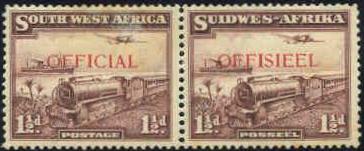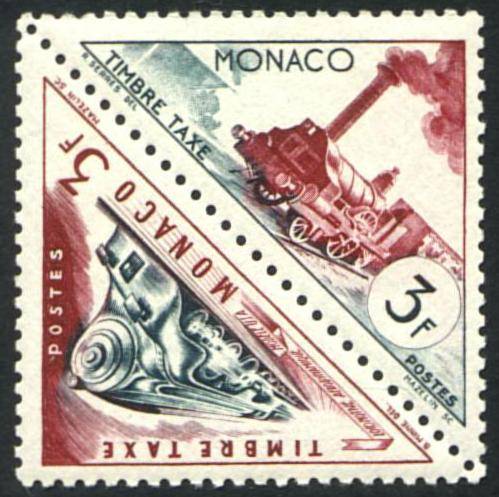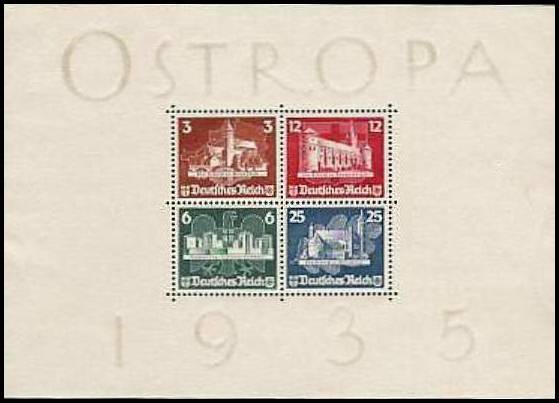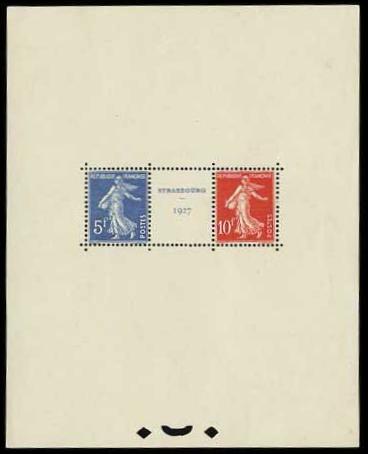

| Home | S is for Setenant <<< | Contents | >>> S is for Stamp Box | Credits |
WHAT WAS THE FIRST SETENANT WORLD-WIDE?
12/05/2004 - I just discovered Nick Blackburn's very informative and entertaining site about stamp collecting, with a page that lists various firsts worldwide, including "First Composite".
That's on his "First Firsts" page, at http://www.snap-dragon.com/first_firsts.htm, where he reveals the first examples worldwide of various types of stamps such as First Airmail, First Booklet, First Multi-lilngual, etc. And First Composite.
I like Firsts, so I was intrigued, but I had never seen or heard the term "composite," so I wrote and told him the correct term is "setenant," to which he replied - "I took that from Mackay's book, Philatelic Terms Illustrated."
I own a copy of that book, so I consulted it and found that it says:
Composite Stamps. Stamps in which the design is spread over two or more stamps.
I see. So the first US setenant issue, the Christmas greenery, is NOT a composite, but the second, the Space Twins, is.
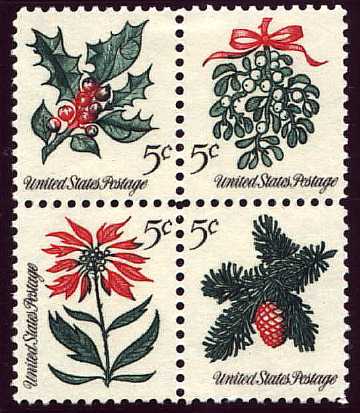

First two US Setenants, 1964 and 1967
For "setenant" Mackay's book says:
SE-TENANT. French expression signifying "joined together." Used to describe adjoining stamps or labels which differ from each other in value, inscription, design, colour, or some other respect, such as one overprinted or surcharged, and the other not. Stamp booklets and coil strips often include different stamps side by side, but this practice has become increasingly fashionable in sheets of stamps where it is used to create composite designs.
Reluctant to open a can of worms, I nonetheless started looking through all my philatelic reference works to see whether this term "composite" appeared elsewhere, and what the formal definition of "setenant" was. I checked nine other philatelic glossaries and dictionaries and encyclopedias, and found the following:
1. None includes the term "composite."
2. All have "setenant" or "se-tenant," but some say it applies to ANY pair of stamps joined together, others say it applies ONLY if their designs differ.
Wait, the AskPhil glossary (no longer available) says
Composite Sheet: sheet of stamps made up of different values, types or designs.
Composite Stamps: different values, types or designs on two or more joined stamps.
Se-tenant (Seten.): (Fr.) (joined together), two or more unseparated stamps having different colors, denominations, or designs.
So they have a definition of composite, but it differs from Mackay's, and their definition of setenant agrees with mine - not just any joined pair, but ones with differing designs.
I noticed that Mackay is British, so the difference in terms may be partly a difference of local customs.
But the term "composite", meaning a design spread over two or more stamps, does seem useful to distinguish the two types of setenants. What is the other called, then, when each stamp has an independent design? A "non-composite setenant?" That's very awkward.
Nick identifies the pair below as the first composite design setenant, Poland Scott 767-68, issued in 1957.
But now he and I wonder -
What was the first setenant world-wide?
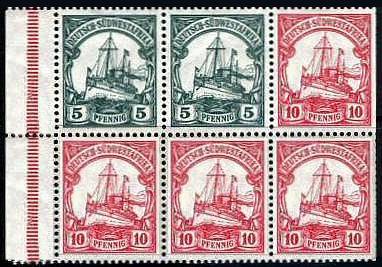 GSWA 27b, 1906 |
 Cameroun 21-22, 1905 |
 Germany 82-83, 1905 |
I did a little research, and if we can agree that setenant means joined stamps
with different designs, and the difference must
be intentional (let's rule out errors), then so far the earliest setenants
I have found are from Germany and its colonies pre-WWI, e.g. German Southwest Africa 27b, a
booklet pane of six stamps, four of one denomination (#28), two of another(#27),
showing the Kaiser's yacht, "Hohenzollern".
All Scott says about the issue date is 1906-19.
Stamps of the same design and format were issued by Cameroun, issue dates 1905-18, Scott 21 and 22.
Germany itself issued
similar booklet panes with Scott 82 and 83, 1905-19, but showing Germania, rather than the yacht.
Michel is a little more helpful. It lists the approximate issue dates of the booklets
as April, 1913 for the German one, and mid-1913 for the other two. It makes sense that the
German one would have been first, so let's say April, 1913
is the date to beat - that at least sets a starting point.
South Africa and Southwest Africa printed stamps with English and Afrikaans on setenant pairs, but that didn't start until 1923, so we needn't consider those.
Tete-beche (joined stamps, with their designs in opposite directions)? Doesn't count, since once they have been separated the stamps are identical.
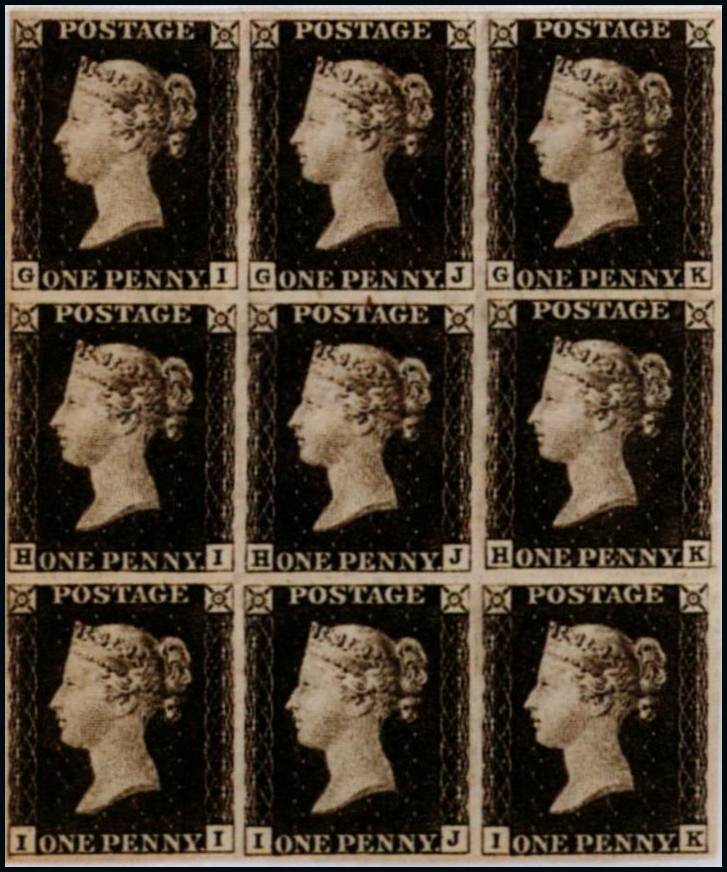
Great Britain - Scott 1 - Block of nine, 1840
Then it occurred to me that the first stamp of all, the Penny Black, is a setenant issue - each stamp on the sheet is unique in its corner letters! Above is a block of nine (from a full sheet of 240), from rows G through I, columns I through K.
I think we should rule that out (the same device was used on all of the early GB issues, it was intended as a security device, and to help with book-keeping). And I think we should exclude as well anything related to overprints.
 Austria 11 with St. Andrews Cross 1858 |
 Great Britain 143b with St. Andrews Cross 1906 |
 Ireland 66b with advertising labels 1922 |
We should also exclude labels, there were many booklet panes and some sheets of stamps with advertising or just an X to take up an empty space on the pane - read more about the X's on my X page.
So the German booklets are still the earliest setenants I can find. Anyone care to propose a candidate earlier than 1913?
March 29, 2009 - An anonymous visitor to this site wrote to suggest that the famous St Louis Bears (shown below) are the earliest setenant stamps, since they were printed in sheetlets of six, with three of the 5 cent stamps, and three of the tens.

St Louis Bears
November, 1845

Largest known multiple
The full story of the St Louis Bears can be read HERE.
April 24, 2011 - Benjamin Folkman wrote to point out that the famous Providence Provisionals - "just as early as the St. Louis Bears" (well, not quite) - were printed on sheets of twelve and contained eleven 5c stamps along with one 10c stamp, the latter in the top right position. Image of the setenant pair below. Image of the full sheet (thanks Siegel) HERE. And thanks, Benjamin.

Providence Provisionals
issued August 24, 1846
What about the earliest modern setenant?
... whether composite design or not,
that is, the first one printed for artistic purposes, rather than practical ones?
We shall rule out errors, overprints, dual-language pairs such as those from South Africa,
and anything else done out of necessity or carelessness. I think I have seen rectangular
stamps perforated diagonally, the halves to be used as bisects. Let's exclude those,
they were probably an emergency or economy measure.
We'll exclude also the Parcel Post
issues of Italy and its colonies, which had two halves, one to be glued onto the waybill, the other
onto the sender's receipt. Those were first issued in 1914, Scott Italy Q7-19.
And again Tete-beche doesn't count, since once separated the stamps are identical.
It must be at least two
stamps, with different designs, side by side (or top to bottom), issued that way because
the designer said "Hey, wouldn't it be cool to use more than one design on the same sheet?"
(or the equivalent in the language of his day.)
Is that Poland 767-68, issued in 1957? Or is there one earlier?
--------------------------------------------
Monaco J41 and 50, 1953
If we allow Postage Due stamps,
Monaco J39-56 were triangular stamps printed in pairs, setenant. They were issued
June 29, 1953. If we exclude Postage Dues, some of those same stamps were overprinted
for ordinary postal use in 1956, and have Scott numbers 371-390 and C49-50. But
I said we would exclude overprints.
-----------------------------------------------------------------------------------
Australian Postage Stamp Centenary Issue, 1950
In 1950, for its postage stamp centenary, Australia issued two stamps, Scott 228 and 229,
printed in sheets of 160, the two designs alternating. This certainly qualifies.
--------------------------------------------
In 1949, to celebrate its postage stamp centenary,
France issued 4 stamps, Scott 612-615, printed on the same sheet in 10 strips
of 4 stamps plus a label, half perfed, half imperf. These surely qualify.
France B153-157, 1943
In 1943 France issued TWO setenants.
B149-152 was four stamps with two different denominations, each denomination
printed in two colors, rose red and blue. These were printed in sheets of five vertical rows
of five stamps, row 1 being design 1 in blue, row two being design 2 in blue, row
3 a label, row 4 design 2 in red, row 5 design 1 in red. So
in this case there are setenant pairs with differing designs.
That same year,
B153-157 had five different stamps in a horizontal strip, with 4 or 5 strips(?) to a full pane.
In 1942, France issued two semi-postal stamps, B147 and 148, both having the same design and
denomination, but in different colors, and printed in sheets of five rows of 5 stamps,
two rows of the dark blue,
one row of albino impressions, and two rows of crimson. Does this qualify?
One cannot have the two designs actually adjacent as a pair, they are always
separated by the albino impression.
DOES AN
ALBINO IMPRESSION COUNT AS A STAMP?
Does the albino impression beween France Scott B147 and B148 count as a stamp?
The
AskPhil Glossary (no longer available) defines "albino impression" as
"A die impression on a stamp or stamped envelope
where the ink has not been transferred to the paper."
So the blank "stamp" between the red and blue stamps shown
above is not really blank. Supposedly it has an uninked impression of the
same design, though presumably very faint, but I've never seen
the actual stamps, only scans, so I can't say how visible it is.
But Scott does not assign it a number, or price it, so I guess it's not a stamp.
USUALLY ALBINOS ARE ERRORS.
This is the only instance I know of where an albino impression
of a stamp was created INTENTIONALLY.
Can anyone point out other intentional albinos?
------------------------------------
France 329 a-d, 1937
If we allow souvenir sheets, France issued one in 1937 with four different stamps
in two vertical rows of two, separated by a row of labels. That was Scott 329.
As issued it had broad borders on all sides, but once they have been removed, the
result looks like this:
Those look like setenant pairs to me.
------------------------------
U.S.A. 778 - 1936
But that is beaten by Scott US 778, a souvenir sheet.
It was issued in 1936, with four designs in a block, setenant and imperforate.
Again, if we cut off the borders, it looks better as a setenant design.
------------------------------------------------------
Gemany B68 - OSTROPA, 1935
Germany can beat that - Scott B68, 1935, another souvenir sheet (I'm detecting a theme here),
with four different stamps, setenant.
OSTROPA was an International Phlatelic Exhibition, held in Konigsberg, Sweden,
June 23 to July 3, 1935.
----------------------------------------------------------------------------------------------------
Italy C48 and 49 -
Balbo's Trans-Atlantic Flight Issue, 1933
Italy's first setenant was still earlier - Scott C48 and 49,
May 20, 1933, a set of airmail stamps in celebration of the historic
flight of General Italo Balbo's 24-seaplane squadron across the Atlantic to the
Chicago World's Fair.
These stamps were printed in
two panes of 60 stamps each, comprising 20 strips of three.
The leftmost stamp is an Express label, with no postal value.
--------------------------------------------------
Gemany B33 - IPOSTA, 1930
Still from Germany - Scott B33. Yes, a souvenir sheet,
with four different stamps, setenant.
IPOSTA was an International Phlatelic Exhibition, held in Berlin September 12-21, 1930.
The souvenir sheet is 105x150 mm (about 4"X6"). Each holder of an admission ticket
was entitled to purchase one sheet. (Scott, vol. 3)
--------------------------------------------------
France 241, 1927
Back to France again - in 1927 they issued a souvenir sheet for the Strasbourg Exhibition,
with two stamps separated by a label. Again, that label could be a problem -
is this a setenant issue? Even if not, France
certainly seems to have issued the most setenants back when they were something special.
That's the earliest "modern" or "artistic" setenant I can find (i.e., one created for
artistic or design purposes).
Can you find an earlier "artistic" setenant?
Send feedback to the webmaster:
CLICK HERE
Created -- 12/05/2004




Italian Parcel Post stamps - designs of 1946 overprinted
for use in Trieste
French Postage Stamp Centenary Issue, 1949

France B149-152, 1943
France B147-148, 1942


The souvenir sheet is 104x148 mm (about 4"X6"). (Scott, vol. 3)
Or, if you prefer to exclude souvenir sheets, what's the earliest then?
All responses are welcome. Send your findings to posterstampcc@gmail.com
Home
S is for Setenant <<<
Contents
>>> S is for Stamp Box
Credits
Revised -- 07/19/2011

